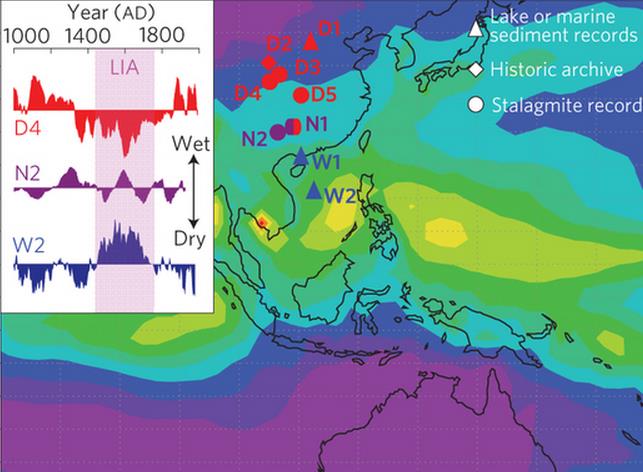Precipitation in low latitudes is primarily controlled by the position of the intertropical convergence zone, which migrates from south to north seasonally. The Little Ice Age (defined as AD 1400–1850) was associated with low solar irradiance and high atmospheric aerosol concentrations as a result of several large volcanic eruptions. The mean position of the intertropical convergence zone over the western Pacific has been proposed to have shifted southwards during this interval, which would lead to relatively dry Little Ice Age conditions in the northern extent of the intertropical convergence zone and wet conditions around its southern limit. However, here we present a synthesis of palaeo-hydrology records from the Asian–Australian monsoon area that documents a rainfall distribution that distinctly violates the expected pattern. Our synthesis instead documents a synchronous retreat of the East Asian Summer Monsoon and the Australian Summer Monsoon into the tropics during the Little Ice Age, a pattern supported by the results of our climate model simulation of tropical precipitation over the past millennium. We suggest that this pattern over the western Pacific is best explained by a contraction in the latitudinal range over which the intertropical convergence zone seasonally migrates during the Little Ice Age. We therefore propose that rather than a strict north–south migration, the intertropical convergence zone in this region may instead expand and contract over decadal to centennial timescales in response to external forcing.

Tropical rainfall varies in association with the seasonal migrations of the circum-global intertropical convergence zone (ITCZ) and the closely related monsoonal land–sea coupled systems. On millennial to orbital timescales, both palaeoclimate proxy research and climate modelling have suggested that the precipitation in the tropical and subtropical monsoon areas varies in parallel with latitudinal migration of the ITCZ, being characterized by opposing variations in the two hemispheres1, 2, 3, 4, 5. With southward migration of the ITCZ, the precipitation in the Northern Hemisphere summer monsoon area decreases whereas the precipitation in the Southern Hemisphere summer monsoon area increases; and vice versa. Climate models suggest that the millennial to orbital timescale migration of the mean annual position of the ITCZ is related to changes in Northern Hemisphere high-latitude climate, the Atlantic meridional overturning circulation and the asymmetrical insolation input between hemispheres1, 2, 3, 4, 6. A southward migration of the ITCZ occurs when the North Atlantic region is relatively cold owing to enhanced high-latitude ice cover and a slowdown of the Atlantic meridional overturning circulation1, 2, 3. Conversely, a northward migration of the ITCZ mean position is usually driven by increased Northern Hemisphere insolation input relative to the Southern Hemisphere2, 4, 6.
The dynamical variation of the ITCZ rainbelt has also been considered the main factor for centennial timescale hydrologic changes in tropical areas over the past millennium7, 8. A large body of palaeo-proxy evidence suggests that during the relatively cold Little Ice Age period (LIA, ~AD 1400–1850), regions located at the northern limit of the ITCZ rainbelt, including the pan-Caribbean region6, 9, became drier relative to both the warm Medieval Climate Anomaly period (MCA, ~AD 800–1300) and the most recent 150 years, pointing to a possible southward shift of the ITCZ (refs 7, 8). Meanwhile, some hydrologic records from the southern boundary of the ITCZ that reflect a wetter LIA are also evidence in support of southward migration of the ITCZ mean position8, 10, 11.
Although a similar/parallel southward migration of the ITCZ has been described during the LIA in open ocean areas of the Pacific7, the pattern of change for the west Pacific marine–continental ITCZ remains less well established12. In this study, we synthesized high-resolution palaeo-hydrology records from the East Asian–Australian summer monsoon regions during the past millennium to test the variation pattern of the west Pacific ITCZ. Surprisingly, we found that the west Pacific region has yielded a precipitation distribution pattern in contradiction to what would normally be predicted from the southward shift of the ITCZ mean position during the LIA. Instead of the expected pattern, both the East Asian Summer Monsoon (EASM) and the Australian Summer Monsoon (ASM) retreated synchronously during the LIA and the core precipitation zones converged more narrowly within the tropics.

